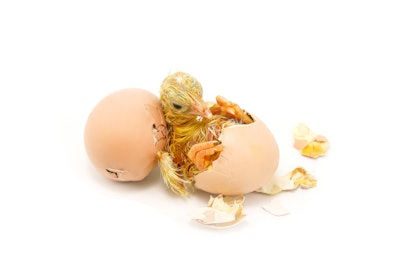
Peroxide was found as the most effective egg wash sanitizer to both remove Salmonella from the shell’s surface and to keep the cuticle intact in a recent research study.
“Salmonella is frequently found on hatch eggs even after they go through the sanitation process,” said Ted Brown, Cargill Global Food Safety & Scientific Services, at the 2024 International Production and Processing Expo.
“So, we conducted research to find a sanitizer that is effective at reducing Salmonella on hatch eggs without damaging the cuticle.”
The study evaluated how multiple egg wash sanitizers, including thymol, peracetic acid (PAA), bromine, peroxide and quaternary ammonium, reduced Salmonella levels on the surface of inoculated eggs, without damaging the egg cuticles, when compared to an unwashed treatment.
Specifically, the peroxide product was the most effective egg sanitizer, reducing Salmonella prevalence on the egg surface by over 73%. The thymol product was the least effective sanitizer and only reduced Salmonella prevalence by less than 5%.
Brown explained that the project was conducted to update producers on new and current egg washes and to guide the industry on best practices for mitigating Salmonella contamination in, and on, hatching eggs during the wash process.
Currently, chlorine is the primary sanitizer used by breeders for egg sanitation in the processing plant, explained Brown. However, chlorine dissociates quickly in the presence of organic loads, can be corrosive to equipment and requires strict management to use effectively.
In the future, Brown said that he hopes to conduct an additional study to ensure that the hatch rate is not negatively affected by the sanitizers.
How to guard against Salmonella in the hatchery
Factors such as warm temperatures and moisture encourage the spread of Salmonella in hatcheries.
To prevent the spread of Salmonella in the hatchery, Don Waldrip, DVM, Zoetis technical services veterinarian offers the following five tips:
1. Pay attention to disinfection and cleanliness at all stages in the hatchery.
2. Keep broiler-breeder eggs clean and off the floor. hen eggs do drop to the floor, discard them.
3. Ventilation and air-handling units need to be cleaned regularly. These units can pull in air that is contaminated with Salmonella.
4. Take additional measures to prevent bacterial infections if no antibiotics are used during in-ovo vaccination.
5. Find ways to rely more on robotics and automation to do certain tasks in the hatchery because people can be a carrier of Salmonella.


















